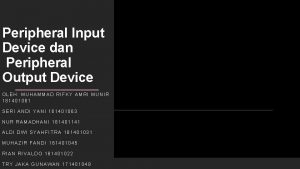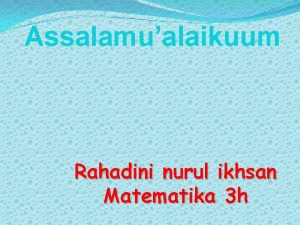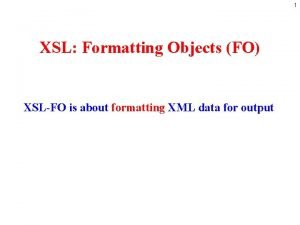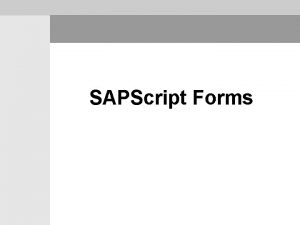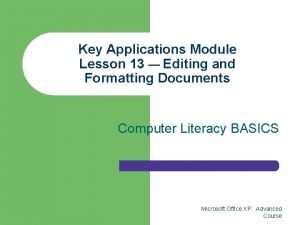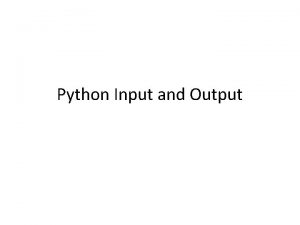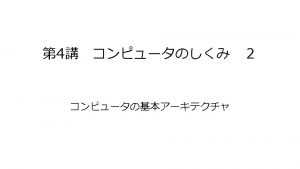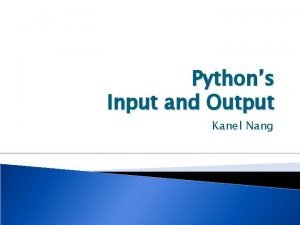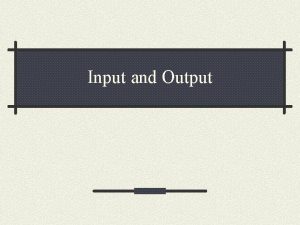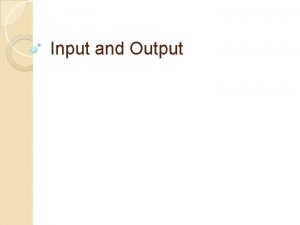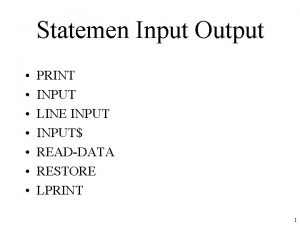PYTHON Input Output Lakshit Dhanda Output Formatting Python













- Slides: 13

PYTHON Input & Output Lakshit Dhanda

Output Formatting �Python has ways to convert any value to a string. � 2 Methods �repr() – meant to generate representations of values read by the interpreter. �str() – meant to return representation which are human readable. �Values such as numbers or structures like lists and dictionaries, have the same representation using either function.

�>>> s = 'Hello, world. ' �>>> str(s) 'Hello, world. ' �>>> repr(s) “ 'Hello, world. ‘ " �>>> str(1. 0/7. 0) '0. 142857' �>>> repr(1. 0/7. 0) '0. 14285714285'

�The repr() of a string adds string quotes and backslashes: >>> hello = 'hello, worldn' �>>> hellos = repr(hello) �>>> print hellos 'hello, worldn' �The argument to repr() may be any Python object. >>> repr((x, y, ('spam', 'eggs'))) "(32. 5, 40000, ('spam', 'eggs'))"

�str. rjust() method of string objects right-justifies a string in a field of a given width by padding it with spaces on the left. �There are similar methods str. ljust() and str. center(). �These methods do not write anything, they just return a new string. �If the input string is too long, they don’t truncate it, but return it unchanged.

�There is another method, str. zfill(), which pads a numeric string on the left with zeros. It understands about plus and minus signs. �>>> '12'. zfill(5) '00012' �>>> '-3. 14'. zfill(7) '-003. 14'

�str. format() is another function used to format the output. �>>> print '{0} and {1}'. format('spam', 'eggs') spam and eggs �A number in the brackets refers to the position of the object passed into the method. �Positional and keyword arguments can be arbitrarily combined. �>>> print 'The story of {0}, {1}, and {other}. '. format('Bill', 'Manfred', other='Georg') The story of Bill, Manfred, and Georg.

�'!s' (apply str()) and '!r' (apply repr()) can be used to convert the value before it is formatted. �>>> print 'The value of PI is approximately {!r}. '. format(math. pi) The value of PI is approximately 3. 141592653589793. �An optional ': ' and format specifier can follow the field name. Passing an integer after the ': ' will cause that field to be a minimum number of characters wide. This is useful for making tables pretty.

Variable reference �You can reference the variables to be formatted by name instead of by position. �This can be done by simply passing the dict and using square brackets '[]' to access the keys. �>>> table = {'Sjoerd': 4127, 'Jack': 4098, 'Dcab': 8637678} �>>> print ('Jack: {0[Jack]: d}; Sjoerd: {0[Sjoerd]: d}; ‘ 'Dcab: {0[Dcab]: d}’. format(table)) Jack: 4098; Sjoerd: 4127; Dcab: 8637678

Reading & Writing Files �open() returns a file object, and is most commonly used with two arguments: open(filename, mode). �Modes : r – read, w – write, a – append, r+ - both read and write. �>>> f = open('/tmp/workfile', 'w') �>>> print f <open file '/tmp/workfile', mode 'w' at 80 a 0960>

Methods of File Objects �read(size) - reads some quantity of data and returns it as a string. Size is an optional numeric argument. �readline() reads a single line from the file. �write(string) writes the contents of string to the file, returning None. �To write something other than a string, it needs to be converted to a string first.

�tell() returns an integer giving the file object’s current position in the file, measured in bytes from the beginning of the file. �Use seek(offset, from_what) to change the file object’s position. �The position is computed from adding offset to a reference point; the reference point is selected by the from_what argument. � from_what values : 0 - measures from the beginning of the file 1 uses the current file position 2 uses the end of the file as the reference point.

Pickle Module �Python provides a standard module called pickle. �It can take almost any Python object and convert it to a string representation. �This process is called pickling. �Reconstructing the object from the string representation is called unpickling. �If you have an object x, and a file object f that’s been opened for writing pickle. dump(x, f) �To unpickle the object again, if f is a file object which has been opened for reading. x = pickle. load(f)
 Amita dhanda
Amita dhanda Perangkat keras output
Perangkat keras output Characteristics of natural approach
Characteristics of natural approach Gambar toolbar formatting
Gambar toolbar formatting Optical disk
Optical disk Text box formatting
Text box formatting Modified block style mixed punctuation
Modified block style mixed punctuation Formatting in digital communication
Formatting in digital communication Xsl-fo
Xsl-fo Sapscript define variable
Sapscript define variable Apa title page
Apa title page Text box formatting
Text box formatting Sqlplus format output
Sqlplus format output Paragraph formatting
Paragraph formatting

